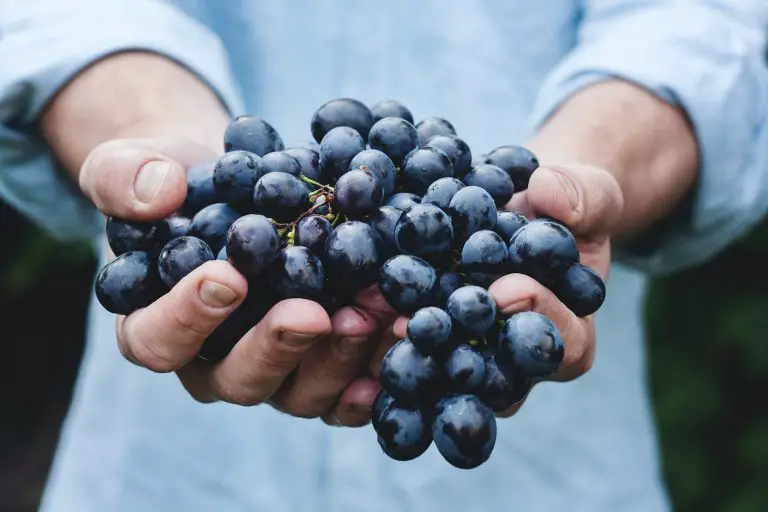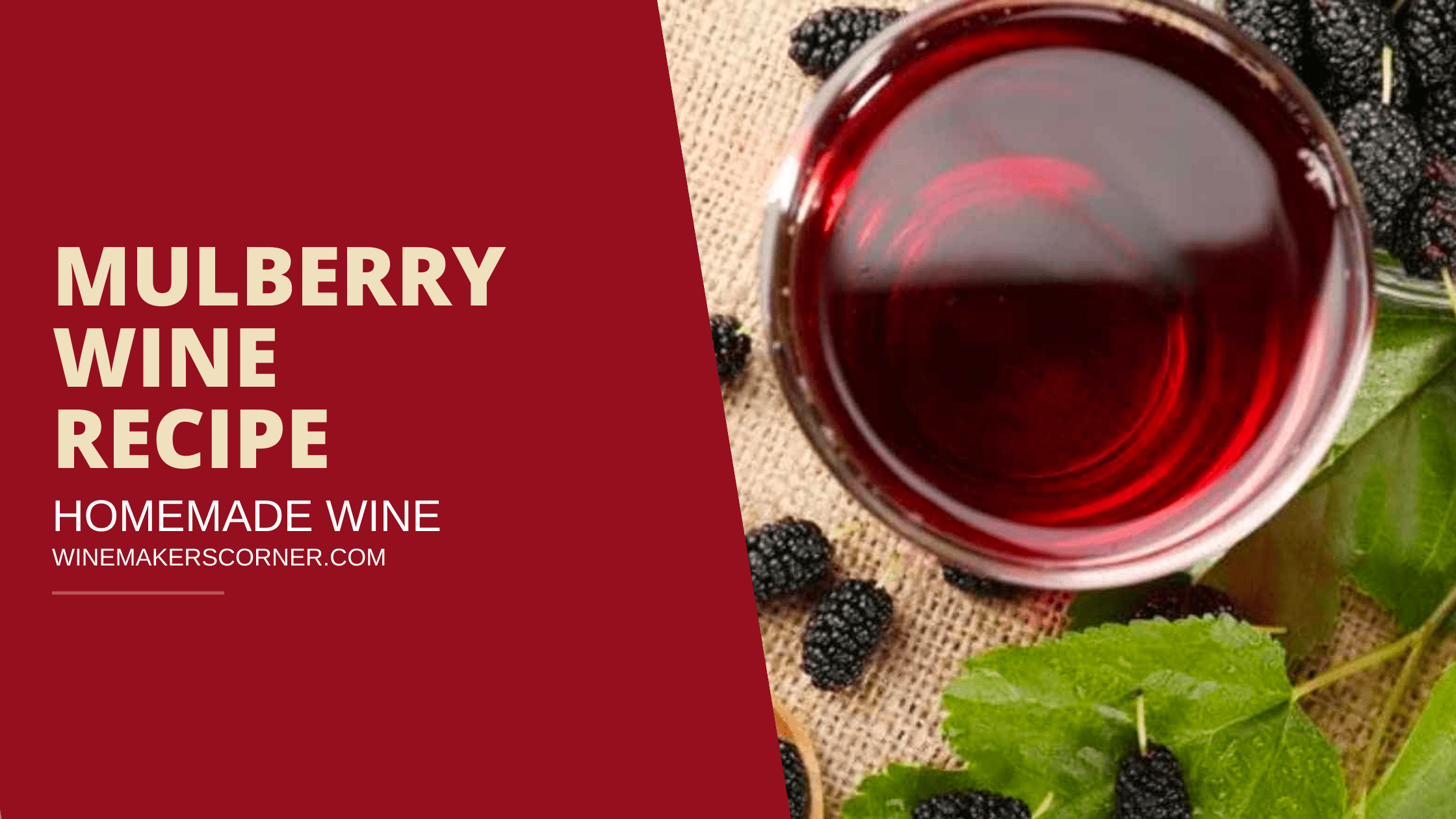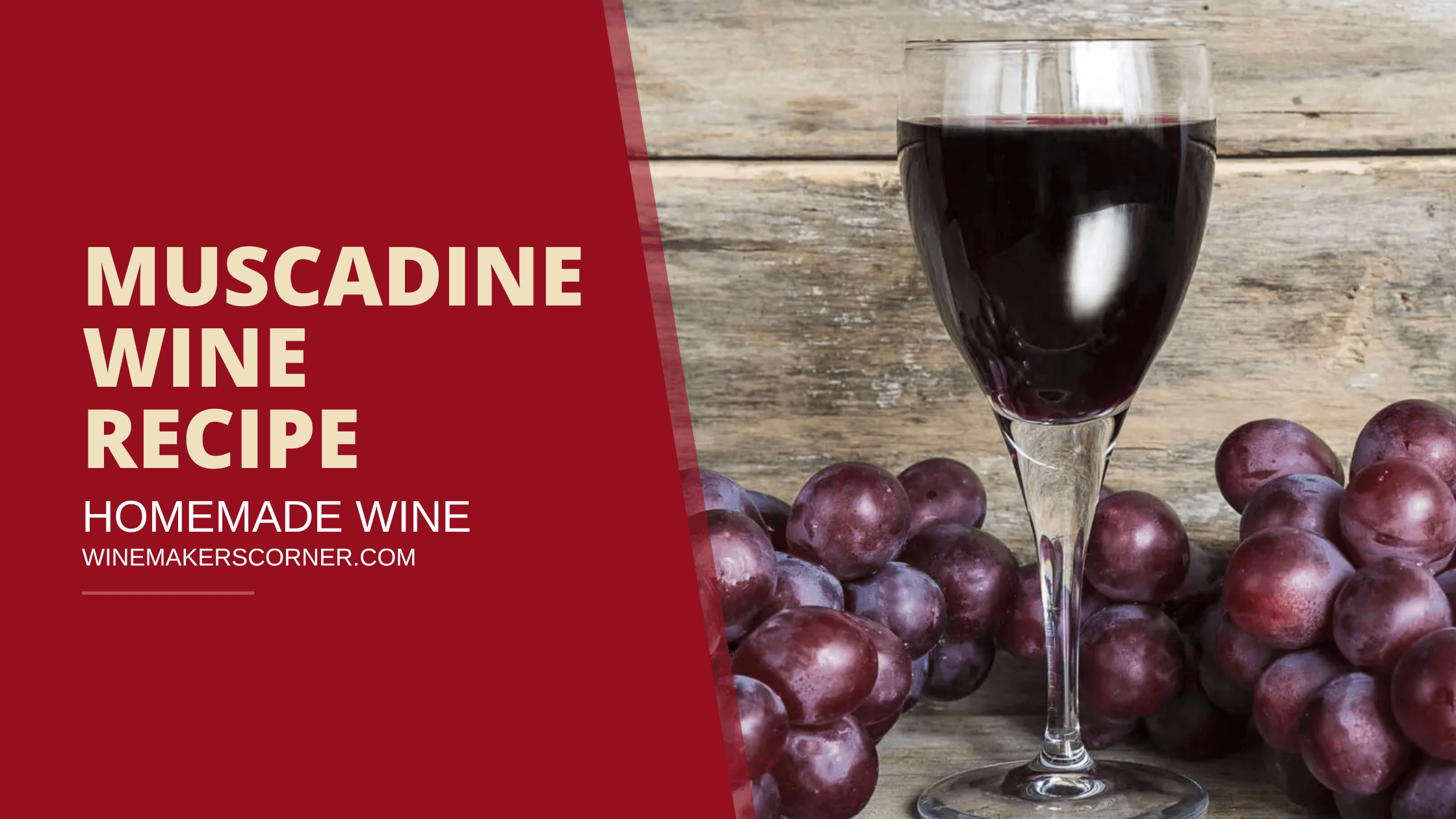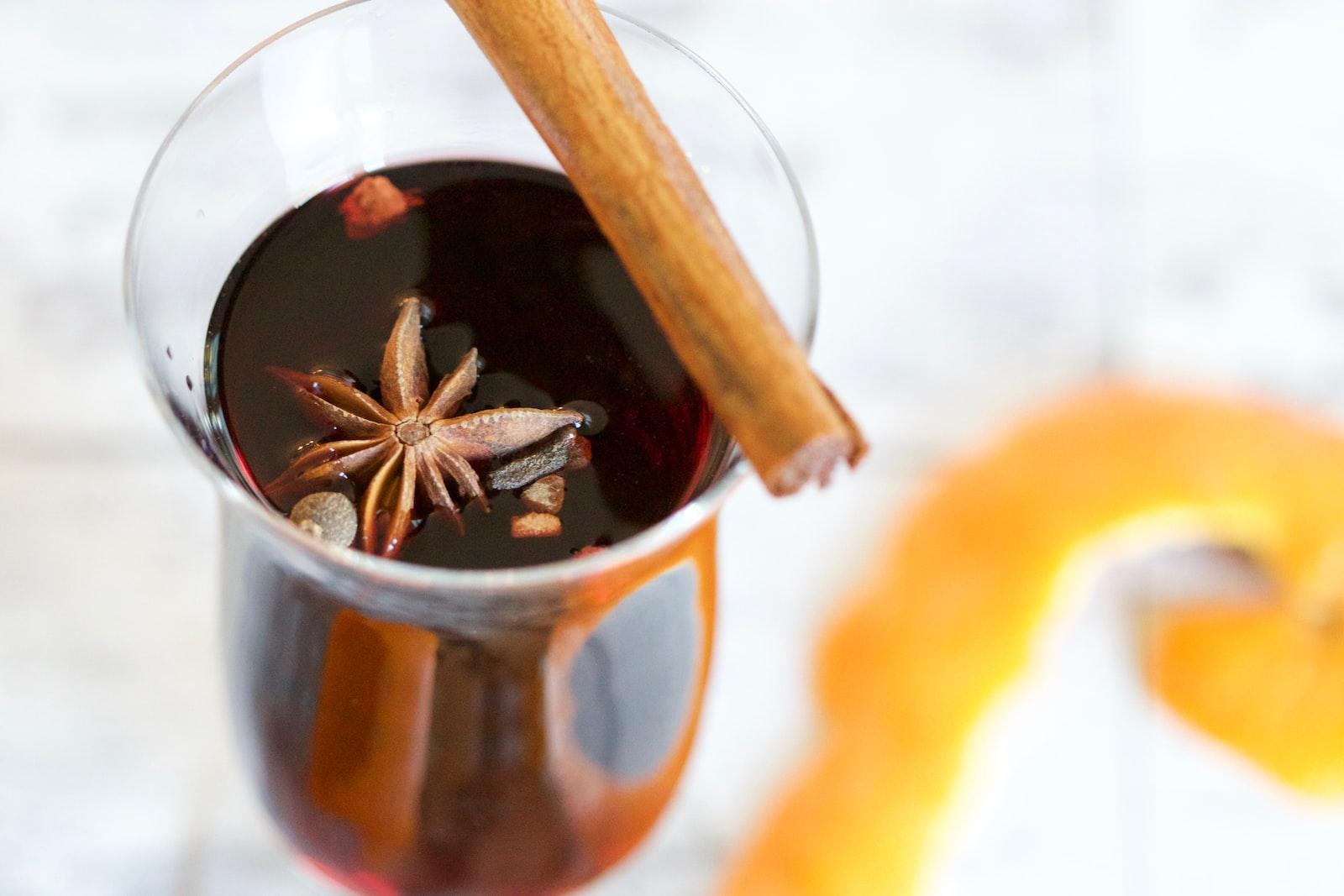Our sweet concord grape wine recipe is a good one. Concord grapes are fairly common in the eastern united states. Concord grapes actually have less sugar than traditional wine grapes and can be made in a range of styles. We prefer the sweeter style with some added sugars. Due to the nature of the skins on concord grapes, they tend to slip off and cause fewer tannins to be extracted into the wine. You get more of a grape taste and low tannin flavor in concord grape wine.
Table of Contents
The Recipe for Concord Grape Wine
Ingredients:
- 60-75 pounds (27-34 kg) fresh grapes
- 20 drops (1 mL) pectic enzyme liquid
- 17-20 Campden tablets or 1½-2 teapoons (9.3-12.4 g) potassium metabisulfite powder
- 1 package (5 g) Red Star Côtes des Blancs or Lalvin 71B-1122 yeast
- 3 teaspoons (8.8 g) yeast nutrient
Instructions:
- Sanitize all equipment.
- Remove any spoiled grapes from the clusters and then crush the grapes. Place them in a fermentation container. Remove grape stems from the container. Add 20 drops (1 mL) of pectic enzyme liquid to the crushed grapes and juice.
- Add 5 crushed Campden tablets or ½ teaspoon (3.1 g) of potassium metabisulfite powder. Stir the juice and crushed grapes and let sit overnight.
- The second day, test for sugar and acid and make appropriate adjustments.
- Make a yeast starter by pouring 4 ounces (120 mL) of grape juice and 4 ounces (120 mL) of lukewarm water into a bowl, sprinkle in the yeast, and let proliferate for 30 minutes. Add this yeast starter and the yeast nutrient to the must and stir well. Cover the container loosely with a sheet of plastic.
- Fermentation will start in 2 or 3 days and continue for 7 to 12 days. The cap (the pulp, skins, and so on) will rise to the top, so twice daily push it down with a sanitized spoon. This allows the color and body to be extracted from the skin and pulp mixture.
- Monitor the wine each day with a hydrometer. When the specific gravity reaches 1.000 or lower, it’s time to press out the wine and store it in another container.
- Sanitize a 5-gallon (19 L) glass carboy. Put in 5 crushed Campden tablets or ½ teaspoon (3.1 g) of potassium metabisulfite powder, then transfer the wine into the container, leaving behind the sediment.
- Let the wine sit 3 to 4 weeks, then rack again into a sanitized carboy. Three or four more rackings, 4 to 6 weeks apart, should pace the wine to its finish. After the second racking, use just 3 crushed Campden tablets or ¼ teaspoon (1.4 g) potassium metabisulfite powder.
- The wine should clear itself. If it doesn’t, wait longer and rack until the wine clears.
- When the wine is clear, it’s time to bottle. Make adjustments if needed, then bottle the wine and wait at least 6 months before tasting.
How do you make wine at home?
Making wine at home can be a fun and rewarding hobby. The process of making wine at home is not overly complicated, but it does require patience and attention to detail. Here are the steps to making your own wine at home:
- Choose the type of wine you want to make. There are many different types of wines you can make, from reds to whites and even sparkling wines. Decide which type you would like to make before you get started.
- Purchase the ingredients. The ingredients for making wine at home are usually easy to find at a local home brewing or winemaking store. You will need a juice or must (concentrated grape juice), yeast, and other additives, depending on the type of wine you are making.
- Sanitize all equipment. Sanitizing all of your equipment is a crucial step in the wine making process. You will need to sanitize any containers, siphons, and other items used for the winemaking process.
- Prepare the juice or must. Depending on the type of wine you are making, you may need to add water, sugar, or other ingredients to the juice or must.
- Pitch the yeast. Add the yeast to the juice or must and stir the mixture to combine.
- Ferment the wine. Place the mixture in a carboy and cover it. Allow the mixture to ferment for a period of time, depending on the type of wine being made.
- Rack the wine. Rack the wine off of the sediment that has settled to the bottom of the carboy.
- Bottle the wine. Carefully siphon the wine from the carboy into bottles. Make sure to save some of the wine to top off the bottles if necessary.
- Age the wine. Allow the bottles to sit for a period of time, depending on the type of wine being made. This will allow the wine to age properly and develop its flavor.
- Enjoy your homemade wine. Once it has been aged, it is time to enjoy your homemade wine!
Making wine at home can be a fun and rewarding hobby. The process is not overly complicated, but it does require patience and attention to detail. With the right supplies and knowledge, you can make your own delicious wine at home.
What equipment do I need to make wine at home?
To make wine at home, you will need some basic equipment. This includes a fermenting vessel such as a carboy, a hydrometer, a siphon hose, a bottle filler, a capper, bottles, a corker, a thermometer, a stirring spoon, and a funnel. You will also need ingredients such as wine yeast, fruit juice, campden tablets, and sulfite.
The carboy is used to ferment the wine. It is a large vessel, often made of glass, which holds the wine while it ferments. You will need a hydrometer to measure the specific gravity of the wine. This will help you determine when the fermentation is complete.
The siphon hose is used to transfer the wine from the carboy to the bottles. A bottle filler is used to ensure that the bottles are filled to the correct level. A capper is then used to cap the bottles.
Bottles are used for storing the wine. You can buy them ready-made or you can make them yourself. If you make them yourself, you will need bottles, a corker, a thermometer, and a funnel.
Finally, you will need ingredients such as wine yeast, fruit juice, campden tablets, and sulfite. These are used to create the desired flavor and aroma of the wine.
Once you have all the equipment and ingredients, you are ready to start making your own wine at home.
Should I use a wine kit or a recipe?
When it comes to making wine, there is no right or wrong answer to the question of whether you should use a wine kit or a recipe. The most important factor is finding a method that works for you.
A wine kit is a great option for beginners who want to get started making wine quickly and easily. Wine kits typically come with all of the ingredients needed to make a specific type of wine, and are often more affordable than buying all of the raw materials separately. As a result, they can be a great way to get your feet wet in the world of wine-making.
On the other hand, if you want to create a unique wine that isn’t available in a kit, or you want to experiment with different ingredients, a recipe might be a better choice. With a recipe, you will have to source the ingredients yourself, but you can have complete control over the taste and character of your final product.
Ultimately, the decision of whether to use a wine kit or a recipe comes down to personal preference. If you’re just getting started, a wine kit is probably the way to go. But if you’re looking for a more creative or custom wine experience, a recipe might be the better choice.
What type of grapes are used to make concord grape wine?
Concord grape wine is made from a specific variety of grapes that are native to United States and Canada. These grapes are known as Vitis labrusca, and they are dark purple in color. The grapes have a sweet flavor, and they are usually used to make both sweet and dry wines. Concord grapes are also used in juice and jelly production. They are also used to make jams, jellies and even flavored syrups. Concord grapes are grown in many areas of the United States, including New York, California, Washington, and Oregon.
What type of flavor does concord grape wine have?
Concord grape wine has a sweet, fruity flavor that resembles a combination of blackberry, grape jelly, and green apple. It is a medium-bodied wine with low acidity and a hint of spiciness. The aromas of Concord grape wine can include notes of sweet grapes, blackberries, and even cinnamon. It is a good choice for sweeter dessert wines or for pairing with lighter foods such as poultry and fish. It can also be enjoyed as an aperitif.
Does concord grape wine pair well with certain foods?
Yes, concord grape wine is known to pair well with many different types of foods. This type of wine is a sweet, fruity variety that has a deep purple hue. It is typically low in tannins, which means it can be enjoyed without the presence of food.
Concord grape wine pairs especially well with dishes that feature bold flavors. For example, it pairs well with steak, hearty stews, curries, and barbecue. The sweetness of the wine is a great complement to the spiciness of these dishes. It also goes well with lighter fare, such as grilled fish, salads, and pastas.
The sweetness of concord grape wine also makes it a great choice for desserts. It pairs well with chocolate desserts, fruit pies, and other sweet treats. It can also be used to make a sweet sangria or a fruity
Does concord grape wine contain sulfites?
Yes, Concord grape wine contains sulfites. Sulfites are a type of sulfur compound that is added to many types of food and drinks as a preservative. In wine, sulfites are used to prevent the wine from spoiling. The amount of sulfites present in wine varies depending on the type of grape used and the winemaking process.
Concord grapes are known for their high concentration of natural sulfites, so Concord grape wines tend to contain more sulfites than wines made with other types of grapes. In the United States, all wines that contain more than 10 parts per million of sulfites must be labeled as containing sulfites.
What is the ideal temperature to serve concord grape wine?
The ideal temperature to serve concord grape wine is between 54-58°F (12-14°C). This temperature range is ideal for allowing the full flavor of the wine to come through while also preventing it from becoming overly bitter or acidic. It is also important to note that this temperature range should be kept consistent throughout the entire serving process.
If the temperature fluctuates too much, the flavors of the wine can become distorted. Additionally, it is important to note that serving concord grape wine at too warm of a temperature may result in a more bitter and acidic flavor, so it is best to err on the side of caution and keep the temperature consistent.
Is concord grape wine sweet or dry?
Concord grape wine can be either sweet or dry, depending on the winemaker’s preference. Sweet Concord grape wines are made by fermenting the grapes with their natural sugars intact, while dry Concord grape wines are made by fermenting the grapes with the sugars removed before fermentation.
Both types of Concord grape wine have a deep, rich flavor with a unique aroma of Concord grapes. Sweet Concord grape wines are a great choice for pairing with desserts and fruit-based dishes, while dry Concord grape wines are best enjoyed with savory dishes.
What is the alcohol content of concord grape wine?
The alcohol content of concord grape wine can vary depending on the type of grape used and the winemaking process. Most concord grape wines have an alcohol content of 10% to 14%, although some can reach 15% or higher. The sweeter varieties of concord grape wine, such as port, have a higher alcohol content than the dryer varieties. Additionally, the alcohol content of a concord grape wine can be affected by the amount of time it is aged and the type of yeast used during fermentation.
How long can concord grape wine be stored before it goes bad?
The shelf life of concord grape wine depends on how it is stored. If it is stored in a cool, dark environment and the bottle is kept sealed, it can last for 2-3 years without any significant degradation of quality. However, if the bottle is opened and exposed to air, the wine should be consumed within 2-3 weeks to ensure optimal flavor and quality. In general, it’s best to consume any wine within a year of purchase, as prolonged storage can negatively affect the flavor.
Are there health benefits associated with drinking concord grape wine?
Yes, there are a number of potential health benefits associated with drinking concord grape wine. Concord grapes have a high concentration of beneficial antioxidants, including resveratrol, which may help protect against heart disease and certain cancers. The polyphenols in concord grape wine may also reduce inflammation, support healthy blood pressure levels, and reduce the risk of stroke. In addition, studies have shown that regular consumption of moderate amounts of concord grape wine can help reduce the risk of type 2 diabetes and help protect against cognitive decline.
Is it easy to make your own concord grape wine at home?
Yes, it is possible to make your own concord grape wine at home. The process is relatively simple and involves the steps of crushing and pressing the grapes, adding yeast to the juice, transferring the mixture to a carboy, and then allowing the mixture to ferment. During the fermentation process, sugar is converted into alcohol, and the flavor and aroma of the grapes will be released into the wine. After fermentation is complete, the wine can be bottled, corked, and aged.
To make your own homemade concord grape wine, you will need a variety of supplies. This will include a primary fermenter, a secondary fermenter, a hydrometer, a winemaking thermometer, a hydrometer test jar, sterilizing solution, and bottles for aging and serving. You will also need a food-grade plastic bucket for crushing and pressing the grapes,
Are there any special techniques used to make concord grape wine?
Yes, there are special techniques used to make concord grape wine. The first step is to select mature concord grapes that are ripe and of good quality. The grapes should be crushed and then pressed to extract the juice. The juice should be fermented in a controlled environment, typically at temperatures between 60-70 degrees Fahrenheit.
After fermentation is complete, the wine can be aged in oak barrels to develop additional complexity, then bottled and enjoyed. Other techniques used to make concord grape wine include fining, filtering, and blending with other grape varieties. Additionally, winemakers may choose to use oak chips, or oak staves, to give the wine an oaky character. Finally, many winemakers use tannins and other additives to increase the complexity and depth of their wines.
What is the best way to store concord grape wine for long-term use?
The best way to store concord grape wine for long-term use is to store it in a cool, dark place. Concord grape wine should be stored at temperatures between 45-55°F, with a humidity level of 70%. The wine should be stored upright to reduce the amount of air that is exposed to the wine.
To ensure that your concord grape wine maintains its flavor, it is important to store it away from light and heat sources. This includes direct sunlight, and any areas that may be prone to fluctuating temperatures. Storing your wine in a wine fridge or a temperature-controlled cellar is a great way to ensure that your wine maintains its flavor and quality.
It is also important to store your wine away from any strong odors. Strong odors, such as garlic, can affect the flavor of your wine, so it is best to store
Is there a difference between the taste of concord grape wine made from fresh grapes and that made from frozen or canned grapes?
Yes, there is a difference in the taste of concord grape wine made from fresh grapes and that made from frozen or canned grapes. Fresh grapes tend to have a much more intense, sweet flavor, whereas frozen or canned grapes often lack the same level of boldness and complexity. Frozen or canned grapes also tend to have less aroma, which can lead to a wine with a more muted flavor profile.
Additionally, using frozen or canned grapes can lead to a wine that is overly tart or bitter, as the grapes lack the naturally occurring sugars found in fresh grapes. Lastly, due to the process of freezing or canning, many of the natural flavor compounds found in fresh grapes can be lost, leading to a wine with a much less pronounced flavor.
Are there any additives used in the making of concord grape wine?
Yes, there are several additives that are used in the making of concord grape wine. These additives are used to enhance the flavor and aromas of the wine, improve its texture, and make it more stable for long-term storage.
Common additives used in the making of concord grape wine include tannins, which help to add structure and complexity to the wine; acidity-regulating agents, which help to balance the sweetness and acidity of the wine; sulfur dioxide, which helps to prevent oxidation during the winemaking process; and enzymes, which help to break down and convert the sugars in the grapes into alcohol. Additionally, preservatives, such as potassium sorbate, may be added to the finished wine to help prevent spoilage.
It is important to note that these additives may differ depending on the winemaker and the type of wine
Can concord grape wine be used to make sangria?
Yes, concord grape wine can be used to make sangria. Sangria is a type of alcoholic beverage typically made with red or white wine, fruit juice, and pieces of fresh fruit. The wine used in sangria can be any type of wine, and concord grape wine is a popular option. Concord grape wine is known for its sweet, grapey taste, making it an ideal choice for sangria. It’s also relatively inexpensive compared to other types of wine, making it a great option for those looking to make the most of their budget.
To make sangria with concord grape wine, mix the wine with your choice of fruit juice and fresh fruit. You can also add brandy, orange liqueur, or other spirits for a more complex flavor. Enjoy your sangria chilled or over ice.
Can concord grape wine be used as a cooking ingredient?
Yes, concord grape wine can be used as a cooking ingredient. It has a sweet, fruity flavor that pairs well with many different dishes. It can be used as a marinade, a glaze, or an ingredient in sauces and dressings. It can also be used to make a reduction sauce to top grilled meats or fish. Concord grape wine can also be used to create desserts and cocktails. The wine’s sweetness can be balanced with other ingredients, such as citrus or spices, to create a unique and flavorful dish.
What is the best way to serve concord grape wine?
The best way to serve Concord grape wine is chilled. A temperature between 9-11ºC (48-52ºF) is ideal for the sweet, fruity flavor of Concord grapes. Additionally, it’s best to use a large glass to allow for the aromas of the wine to come out.
When it comes to food pairings, Concord grape wine pairs well with a variety of foods. It’s especially good with desserts such as cheesecakes, pies, and tarts. It also pairs well with cheese plates, fruit tarts, and chocolate.
When serving the wine, make sure to use a quality wine glass. As with all wines, the aromas are a key part of the experience. Let the wine breathe for a few minutes before serving. Lastly, serve the wine in a chilled glass.
Conclusion
When it comes to crafting a delicious grape wine at home, the Concord grape is a great choice. With its rich flavor and full-bodied body, you can make a delicious and unique wine that is sure to please everyone. The recipe listed above gives a simple and straightforward process for making your own Concord grape wine, with minimal effort and time. With just a few ingredients and supplies, you can experiment with different variations to create your own signature Concord grape wine. So why not try it out? You may be surprised at the delicious beverage you can create at home.




